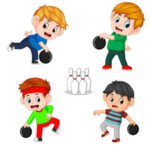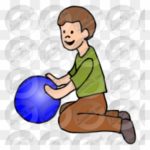
by Santosh | Jun 10, 2020 | Fitness Activity
Movement skills/concepts
Inverted static balance, body and space awareness.
Set-up
Wall, chairs, safety mats.
Mats are scattered in a defined area, with children sharing each mat.
Activity
Shoulder stand: Start in a crouched position with fingers touching the mat. Rock back so your bottom, then back, then shoulders touch the floor. Support your weight by bending your arms at the elbows and supporting your hips with your hands. Hold for 3 seconds and then slowly roll back into a crouched position.

Tripod balance: Start in a crouched position, make a triangle with your hands and head, and walk one knee and then the other onto your elbows. Weight is on the crown of your head, not your forehead. ‘Squeeze’ your fingers.
Handstand: Stand with your back against a wall. Beginning in a squat position, place your hands flat on the mat, keeping your arms straight. Walk up the wall then down, keeping a tight body.

Kick ups: Face the wall, one foot in front of the other (front–back stance). Lean forward and place your hands down on the mat, shoulder width apart and fingers pointing forwards. Using your back leg as a lever, kick your leg upward so that the weight is supported by your arms. Come down safely by twisting your trunk slightly to bring feet down in a new place.
Can you see …?
- wide base of support
- tight body
- control when engaging and disengaging
- support where needed
You could ask …
What do you need to do to balance in an inverted position?
What are some ways you can safely come out of a balance? Show me.
Variations
Inverted balance on equipment: Do a shoulder stand between two chairs. Make sure that the chairs are stable, and that support is available.
COOL DOWN/ CLOSURE
Review Skill/Activity, stretching, and questions.
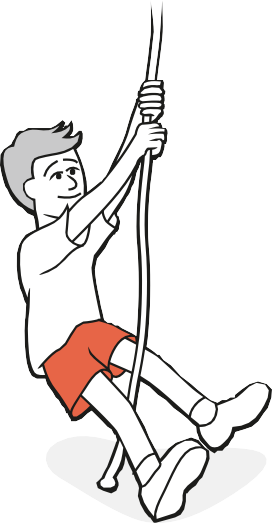
by Santosh | Jun 10, 2020 | Fitness Activity
Movement skills/concepts
Dynamic balance, climbing on equipment at varying heights, angles and spaces.
Set-up
Ropes, ladders, bars, poles, climbing net. Available playground/gymnastic equipment. Individuals or small groups start at different points of a circuit.
Activity
Horizontal ladders: Children move along on all fours, facing downwards and upwards.
Jungle gym and similar equipment: Mark a course on the equipment with numbered tags to follow either in a set order or in any order.
Inclined equipment: Children follow a circuit of ladders, nets, benches, parallel pipes, etc. They then try it in reverse order or help an ‘injured’ partner around.
Vertical ladders/wall bars: Children climb up and down, climb up, across/through and down.
Low, horizontal rope: With a rope over a slippery surface, children lie on their back and pull along with a hand-over-hand action.
Vertical ropes: From sitting on the floor, children pull up hand over hand to standing, then lower hand over hand to sitting.
Combination climbs: Set up an obstacle course using ropes, ladders, bars, nets, beams, boxes, outdoor equipment, etc. Climb this in different ways.
Can you see …?
- alternate, independent foot and leg action
- safe surface for hands
- frequent breaks from walking on the hands
- creative play – children exploring and discovering equipment
You could ask …
How do you adjust your climbing action when climbing up a rope compared to climbing on a fixed structure?
What was the most difficult equipment to climb? Why was this?
COOL DOWN/ CLOSURE
Review Skill/Activity, stretching, and questions.
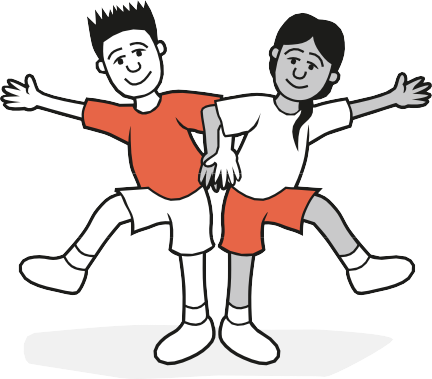
by Santosh | Jun 10, 2020 | Fitness Activity
Movement skills/concepts
Static balance, counterbalance, body and space awareness, problem solving and relationships (with others).
Set-up
Benches, box tops, mats and balls.
Children are in pairs of approximately the same height and size. Each pair has a mat or a defined area to work in.
Activity
With a partner, explore how many ways you can balance. Repeat with only one base of support for each partner.
Repeat one more time, this time without using your foot as a base of support (e.g. using back or hands).
Can you balance with your partner – on a line, bench/box top, or crash pad with only …?
- two feet on the ground
- two hands and one foot
- one foot and two knees
- one back and one foot
With your partner, can you be the shape of …?
- an apple tree
- a yacht
- a letter of the alphabet – try A, D, G, J, P, U – or a number
Can you perform the ‘dead bug carry’? One partner kneels on all fours and the other lies on their back on top. The person underneath then moves around.
Create a sequence of balances, moving smoothly from one balance to another. In groups of 3 or 5, create a pyramid
Can you see …?
- counterbalance
- wide base of support
- slow control when engaging and disengaging
- pairs matched for height and weight
You could ask …
What do you need to do to balance with your partner safely and under control? How can you and your partner counterbalance?
Variations
Vary equipment: Balance in pairs using a ball or rope.
Mirror image balances: In pairs, each partner mirrors the other’s shape.
COOL DOWN/ CLOSURE
Review Skill/Activity, stretching, and questions.
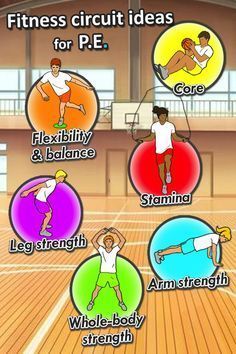
by Neetu | May 28, 2020 | Fitness Activity
Aim
Perform each fitness challenge accurately
Equipment Required
- Four cones for boundaries (same color).
- Spot marker as per need.
- 6 hula-hoops
- 6 Fitness Station Cards
- 1 Health-Related Fitness Challenge Card per group
- 4-6 exercise bands
Play Area Set-Up
- Create a large circle or grid with hula-hoops identifying each station. Number stations 1-6 using Fitness Station Cards.
- Place station cards and pencils inside hoops.
- Create groups of 4-6 students. Send each group to a different station to begin the rotation
Activity Description
- Today we’re going to complete a series of Health-Related Fitness Challenges by working in stations and then rotating after 3 minutes.
- Look at the station number where you’re starting. Be sure to start with the same number on your challenge card (teachers provide an example). Write down how many repetitions of each exercise or challenge you complete.
- I will be at Station 6 helping with your individual assessment
KEY TEACHING POINTS – On signal reset the station equipment and rotate to the next
Grade Level Progression
- Provide detailed instruction for each station and post discussion questions at Station 12. This will allow you to circulate and supervise all stations.
- Provide a brief overview of each station and observe student performance as an assessment of reading and content comprehension.
- Give students 1-minute to read and review the challenge card, then check for understanding.

by Neetu | May 26, 2020 | Sports
Warmup – Intercept the Ball
Intercept the Ball:
Create a 10W x15L grid. Place one player on each end line and one player in the middle of the grid in a one-yard zone.
- The two players on the end lines will try to connect as many passes as they can.
- They will score a point for every pass completed.
- The Interceptor must try to either intercept the pass or deflect the pass out of bounds. 3 Interceptions and the players rotate or 5 deflections and the players rotate.
- All players get to defend in the middle.
- Players on the end line need to pass the ball either in two touches or three touches.
Coach Intervention
- The defender should read visual cues
- Body Shape
- Where the passer looking
- When is he/she striking the ball
- Getting in-line with the ball
- Quick lateral movement
- Do NOT allow straight passes down the line!
Conditional game 5v3+GK
- Coach sets up a 40Lx30W field with a big goal at 1 end and 2 counter goals at the other.
- The team of 3 + GK defends the big goal and tries to score on the 2 counter goals.
- The team of 5 attacks the big goal. The team of 3 + GK tries to avoid getting split and/or giving up a goal.
- The coach will focus on the 2 defenders closest to the ball, how they work together and the roll of the 3rd defender
Coach Intervention
- Pressing defender: getting in-line with the ball
- Working together as a unit
- Quick lateral movement
- Telling each other: Leadership
- How to deny penetration









